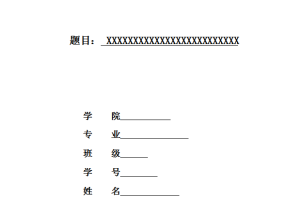Abstract
Business communication, in short, is the process of transferring commerce-related information from someone who has it to someone who needs it, through the use of special forms and techniques designed to enhance the receiver’s comprehension of and response to that information.
Business writing, a useful means of business communication, is extremely important in the daily transactions of exchanging information, ideas and plans; ordering needed supplies; and making decisions, rules, proposals, contracts, agreements, etc.
Strategies applied in business writing are of great significance to effective communication. Therefore, this thesis starts from the importance of effective communication. The first chapter explains the definition of communication and effective communication, the components, the qualities and principles, the significance,and the main obstacles of effective communication. Chapter Two is concerned with message strategy in business writing. The study of the Audience Memory Curve reveals the influence of the communication process upon the memory of the audience, thereby leading to the two basic strategies — the direct approach and the indirect approach. Chapter Three focuses on the specific contents of the direct approach, which is applied popularly in writing good-news messages and routine news messages. Such linguistic features as how to arrange the separate parts of a message into an organic whole with unity and coherence are illustrated with plenty of examples from various business occasions, and supported by to-the-point comments on the use of language. The fourth chapter, which is a counterpart of Chapter Three, centers on the indirect approach, which is employed in communicating bad news. Compared with affirmative replies or routine communication, saying No requires greater language skills. As the use of language is more a matter of application and practice than a matter of theory and guidelines, Chapter Four provides contrasted sample writings to show the effects of different language expressions, again with apt comments. In the fifth chapter, the author gives additional tips for business writing like conversational style and increase of word knowledge.
Key words: Audience Memory Curve, the direct approach, the indirect approach, effective communication.
内容摘要
商务沟通,简而言之,是为了提高对信息的理解能力和回应能力,通过使用特殊的形式和技术,把技术信息从来源者传送到需求者的一个过程。
商务写作,作为沟通的重要方式之一,在日常商务运作, 如交流信息、想法、计划, 订购所需物资,以及拟定决策、规则、建议、合同、协议等活动中, 起到了重要的作用。写作策略的运用在有效的商务沟通中显得尤为重要。本论文从有效沟通的重要性出发,在第一章中阐述了有效沟通的定义,有效沟通所涵盖的组成要素,有效沟通的特性和原则,有效沟通本身所具有的意义以及在现实中所面临的障碍。第二章着重论述商务写作中的消息策略。作者通过对“听众记忆曲线”的研究,阐述了整个沟通过程在听众记忆中所留下的印象,从而引导出两大基本沟通策略 — 直接法和间接法。第三章重点介绍直接法的具体内容和它在“好消息”写作和日常业务信函写作中的广泛应用。本章论述了如何把消息的各个部分统一连贯地组成一个有机的整体, 并举出了不同商务场合的大量沟通实例,采用“逐点对应”的方法对语言用法一一评论。第四章与第三章互为补充,讨论的是在交流坏消息时用到的间接法,与积极肯定的沟通和日常交流相比,拒绝对方需要更巧妙的语言技巧。由于语言的使用虽然是个理论研究课题,但更需要通过实践和应用来提高和加强,因此第四章通过对不同范文的对比,加以适当的评论,来展示不同的语言表达产生的效果反差。在第五章中,作者对于商务写作又补充了一些其他的建议,如采用对话式的写作风格和增进对字、词知识的理解和掌握等。
关键词:听众记忆曲线,直接法,间接法,有效沟通
Contents
Acknowledgement…………………………………………………………………………………………… 2
Abstract…………………………………………………………………………………………………………… 3
Chapter One: The Significance of Effective Communication…………………….. 7
Introduction………………………………………………………………………………………………… 7
1.1 Definition of communication and effective communication………………. 8
1.2 Components of effective communication……………………………………………… 8
1.2.1 Source…………………………………………………………………………………………………….. 8
1.2.2 Audience………………………………………………………………………………………………….. 8
1.2.3 Goal……………………………………………………………………………………………………….. 8
1.2.4 Context……………………………………………………………………………………………………. 9
1.2.5 Message…………………………………………………………………………………………………… 9
1.2.6 Media……………………………………………………………………………………………………… 9
1.2.7 Feedback…………………………………………………………………………………………………. 9
1.3 The qualities of effective communication………………………………………….. 10
1.3.1 Accuracy………………………………………………………………………………………………… 10
1.3.2 Clarity……………………………………………………………………………………………………. 10
Clarity of thinking………………………………………………………………………………………….. 11
Clarity of expression………………………………………………………………………………………. 11
1.3.3 Brevity…………………………………………………………………………………………………… 11
1.3.4 Vigor……………………………………………………………………………………………………… 12
1.4 Principles of effective communications……………………………………………… 12
1.4.1 Positiveness and optimism…………………………………………………………………………… 12
1.4.2 Tact………………………………………………………………………………………………………. 13
1.5 Significance of effective communication……………………………………………. 14
1.5.1 Creating a good reputation…………………………………………………………………………… 15
1.5.2 Saving time and money………………………………………………………………………………. 15
1.6 Main obstacles to effective communication………………………………………. 16
1.6.1 Communication problems in conventions of meaning………………………………………….. 16
Miscommunicated instructions…………………………………………………………………………. 16
Reactions to denotations, connotations and euphemisms………………………………………….. 16
1.6.2 Communication problems in perceptions of reality:…………………………………………….. 17
Abstracting………………………………………………………………………………………………….. 17
Inferring…………………………………………………………………………………………………….. 17
1.6.3 Communication problems involving values, attitudes, & opinions…………………………… 18
Chapter Two: Message Strategy in Effective Business Writing………………. 20
2.1 Business writing as communication……………………………………………………… 20
2.1.1 Purposes of Business Writing……………………………………………………………………….. 20
Requesting and Furnishing Information and Materials……………………………………………… 20
Building Goodwill………………………………………………………………………………………….. 20
2.2 Introduction of Message Strategy………………………………………………………. 21
2.2.1 How can we emphasize?…………………………………………………………………………….. 22
- Direct approach in Message Strategy………………………………………………………………. 22
- Indirect approach in Message Strategy…………………………………………………………….. 24
2.2.2 How can we organize?……………………………………………………………………………….. 25
Chapter Three: The General Direct Approach in Message Strategy……….. 28
3.1 The General Direct Approach…………………………………………………………………. 28
Beginning with the objective………………………………………………………………………………… 28
Presenting necessary explanation………………………………………………………………………….. 28
Covering the remaining part of the objective……………………………………………………………. 29
Ending with adapted goodwill………………………………………………………………………………. 29
3.2 The Advantages of the General Direct Approach…………………………………. 29
3.3 The Applications of Direct Approach in Business Writing…………………… 30
3.3.1 Routine news and its application……………………………………………………………………. 30
Routine messages………………………………………………………………………………………….. 30
3.3.2 Good news and its applications…………………………………………………………………….. 32
“Yes” Replies to Claim Letters………………………………………………………………………….. 32
“Yes” Replies to Requests for Credit…………………………………………………………………… 36
“Yes” Replies to Order Letters………………………………………………………………………….. 40
“Yes” Replies to Requests……………………………………………………………………………….. 42
3.4 Summary of direct approach in business writing……………………………….. 44
Chapter Four: The General Indirect Approach in Message Strategy……… 45
4.1 The general indirect approach……………………………………………………………… 45
4.2 The Advantages of the General Indirect Approach……………………………… 46
4.3 Goals in communicating bad news………………………………………………………… 47
4.4 Difficulties in communicating bad news……………………………………………… 47
4.4.1 Tendency to avoid conflict………………………………………………………………………….. 48
4.4.2 Risk of losing business and personal standing…………………………………………………… 48
4.4.3 Need to be liked and accepted………………………………………………………………………. 49
4.5 The Applications of Indirect Approach in Business Writing……………….. 49
Saying “No” to an adjustment request……………………………………………………………………. 50
Saying “No” to a credit request……………………………………………………………………………. 54
Saying “No” to someone who has ordered merchandise……………………………………………… 57
Saying “No” to a favor request…………………………………………………………………………….. 61
4.6 Other strategies to convey bad news messages…………………………………. 64
4.7 Summary of indirect approach in business writing…………………………….. 65
Chapter Five: Additional Tips for Business Effectiveness……………………….. 66
5.1 Using the Conversational Style……………………………………………………………. 66
5.2 Increase our knowledge of words………………………………………………………. 66
Conclusion…………………………………………………………………………………………………….. 68
Bibliography…………………………………………………………………………………………………. 69





